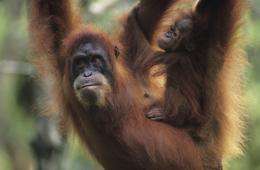Orangutan copy cats (w/ Video)

You know the saying "monkey see, monkey do?" How about "orangutan see, orangutan do?" If that holds true, the small orangutan peering over his mother's shoulder in an enclosure at Zoo Atlanta should learn how to get a tasty treat just by watching how she gets one.
"One of the questions that we were looking at is how individuals learn from one another," says Marietta Dindo, a primatologist studying orangutans and their behaviors. With support from the National Science Foundation (NSF) and in affiliation with the National Zoo in Washington, D.C., Dindo is studying these endangered primates to better understand how our distant ape cousins watch and learn.
"What's interesting and unique about orangutans compared to humans or even other great apes is the fact they're what we call "solitary but social," which means that the individuals, aside from a mother-offspring interaction, will only have limited times where they spend in affiliation with other orangutans," explains Dindo.
Since orangutans in the wild are difficult to observe, Dindo designed an experiment with captive animals. "We had 13 orangutans at the time of the study, and this allowed us to look at what we call a transmission chain: individuals learning like in the game of telephone. I tell you something, then you tell him something and so on, how does that information then pass on? We wanted to see whether or not these orangutans would learn," she continues.
Dindo built a small plastic box with a small door and attached it to the bars of the cage. It allowed the orangutans to slide or lift the door open, and she would give them a treat through the door. Regardless of which method the orangutans used to get the door open, they could always collect a treat behind the door. This meant that the only motivation to conform to one method over the other was what an individual observed another orangutan doing.
In the demonstration, the female orangutan named Madu figured it out right away. Her son, little Dumadi, was paying close attention, but in this case, big mama Madu was so dominant, she kept him at bay and wouldn't let him touch the door. In the actual study, Dindo found equally matched orangutans were superb copy cats, and learned from each other. She also explains that even though they are able copy cats, other studies have shown that apes will only copy each other when it serves their purposes.
"It's known from other research studies that apes won't actually imitate unnecessary actions if they know it's unnecessary," notes Dindo.
Does this orangutan behavior tell us anything about how humans have evolved? Dindo says studies show humans aren't nearly as selective as orangutans. We'll ape each other just to be part of the group. "With humans, what we see is that people want to do as others do and this starts around three years of age--when we start identifying ourselves with others," she says.
So when it comes to following the crowd you might argue that orangutans are more on the ball than we are since they seem to imitate only those actions that they have discovered are necessary to produce the desired outcome the quickest. Meanwhile, humans tend to follow others more precisely and, sometimes, even over imitate to get a similar desired outcome.
However, Dindo is quick to point out that it really depends on your point of view: "Is it intelligent to be as others--when it's so integral to our society and the cultural norm is to do as others do? Well, then yes, it's very smart," says Dindo. "But if you're not going to want to waste your resources and you want to get to your food fast, then that, too, is very smart. So it really depends on where you're coming from."
Provided by National Science Foundation
















